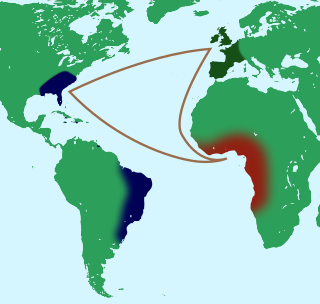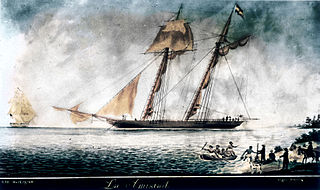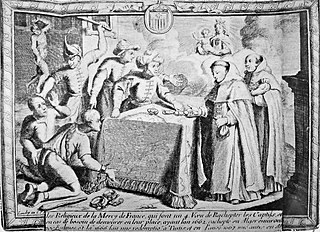The slave narrative is a type of literary genre involving the (written) autobiographical accounts of enslaved Africans, particularly in the Americas. Over six thousand such narratives are estimated to exist; about 150 narratives were published as separate books or pamphlets. In the United States during the Great Depression (1930s), more than 2,300 additional oral histories on life during slavery were collected by writers sponsored and published by the Works Progress Administration, a New Deal program. Most of the 26 audio-recorded interviews are held by the Library of Congress.

The Atlantic slave trade, transatlantic slave trade, or Euro-American slave trade involved the transportation by slave traders of various enslaved African people, mainly to the Americas. The slave trade regularly used the triangular trade route and its Middle Passage, and existed from the 16th to the 19th centuries. The vast majority of those who were enslaved and transported in the transatlantic slave trade were people from Central and West Africa that had been sold by other West Africans to Western European slave traders, while others had been captured directly by the slave traders in coastal raids; Europeans gathered and imprisoned the enslaved at forts on the African coast and then brought them to the Americas. Except for the Portuguese, European slave traders generally did not participate in the raids because life expectancy for Europeans in sub-Saharan Africa was less than one year during the period of the slave trade. The colonial South Atlantic and Caribbean economies were particularly dependent on labour for the production of sugarcane and other commodities. This was viewed as crucial by those Western European states which, in the late 17th and 18th centuries, were vying with one another to create overseas empires.

The Act Prohibiting Importation of Slaves of 1807 is a United States federal law that provided that no new slaves were permitted to be imported into the United States. It took effect on January 1, 1808, the earliest date permitted by the United States Constitution.

The Middle Passage was the stage of the Atlantic slave trade in which millions of enslaved Africans were transported to the Americas as part of the triangular slave trade. Ships departed Europe for African markets with manufactured goods, which were then traded for slaves with rulers of African states and other African slave traders. Slave ships transported the slaves across the Atlantic. The proceeds from selling slaves was then used to buy products such as hides, tobacco, sugar, rum, and raw materials, which would be transported back to northern Europe to complete the triangle.

Triangular trade or triangle trade is trade between three ports or regions. Triangular trade usually evolves when a region has export commodities that are not required in the region from which its major imports come. It thus provides a method for rectifying trade imbalances between the above regions.

Thomas Clarkson was an English abolitionist, and a leading campaigner against the slave trade in the British Empire. He helped found The Society for Effecting the Abolition of the Slave Trade and helped achieve passage of the Slave Trade Act 1807, which ended British trade in slaves.

Olaudah Equiano, known for most of his life as Gustavus Vassa, was a writer and abolitionist from, according to his memoir, the Eboe (Igbo) region of the Kingdom of Benin. Enslaved as a child in Africa, he was taken to the Caribbean and sold as a slave to a Royal Navy officer. He was sold twice more but purchased his freedom in 1766.

The Slave Coast is a historical name formerly used for that part of coastal West Africa along the Bight of Benin that is located between the Volta River and the Lagos Lagoon. The name is derived from the region's history as a major source of African people sold into slavery during the Atlantic slave trade from the early 16th century to the late 19th century.

Slavery in the British and French Caribbean refers to slavery in the parts of the Caribbean dominated by France or the British Empire.

Slave ships were large cargo ships specially built or converted from the 17th to the 19th century for transporting slaves. Such ships were also known as "Guineamen" because the trade involved human trafficking to and from the Guinea coast in West Africa.

La Amistad was a 19th-century two-masted schooner, owned by a Spaniard colonizing Cuba. It became renowned in July 1839 for a slave revolt by Mende captives, who had been captured and sold to European slave traders and illegally transported by a Portuguese ship from West Africa to Cuba in violation of existing European treaties against the Atlantic slave trade. Two Spanish plantation owners, Don José Ruiz and Don Pedro Montes, bought 53 captives, including four children, in Havana, Cuba, and were transporting them on the ship to their plantations near Puerto Príncipe. The revolt began after the schooner's cook jokingly told the slaves that they were to be "killed, salted, and cooked." Sengbe Pieh, a Mende man, also known as Joseph Cinqué, unshackled himself and the others on the third day and started the revolt. They took control of the ship, killing the captain and the cook. In the melee, three Africans were also killed.

The Interesting Narrative of the Life of Olaudah Equiano, Or Gustavus Vassa, The African, first published in 1789 in London, is the autobiography of Olaudah Equiano. The narrative is argued to represent a variety of styles, such as a slavery narrative, travel narrative, and spiritual narrative. The book describes Equiano's time spent in enslavement, and documents his attempts at becoming an independent man through his study of the Bible, and his eventual success in gaining his own freedom and in business thereafter.
Alexander Falconbridge was a British surgeon who took part in four voyages in slave ships between 1782 and 1787. In time he became an abolitionist and in 1788 published An Account of the Slave Trade on the Coast of Africa. In 1791 he was sent by the Anti-Slavery Society to Granville Town, Sierra Leone, a community of freed slaves, where he died a year later in 1792.

The history of slavery spans many cultures, nationalities, and religions from ancient times to the present day. Likewise, its victims have come from many different ethnicities and religious groups. The social, economic, and legal positions of enslaved people have differed vastly in different systems of slavery in different times and places.

Slavery has historically been widespread in Africa. Systems of servitude and slavery were common in parts of Africa in ancient times, as they were in much of the rest of the ancient world. When the trans-Saharan slave trade, Indian Ocean slave trade and Atlantic slave trade began, many of the pre-existing local African slave systems began supplying captives for slave markets outside Africa. Slavery in contemporary Africa is still practised despite it being illegal.

The Barbary slave trade refers to slave markets on the Barbary Coast of North Africa, which included the Ottoman states of Algeria, Tunisia and Tripolitania and the independent sultanate of Morocco, between the 16th and 19th century. The Ottoman states in North Africa were nominally under Ottoman suzerainty, but in reality they were quasi-independent.
Seasoning, or The Seasoning, was the period of adjustment that slave traders and slaveholders subjected African slaves to following their arrival in the Americas. While modern scholarship has occasionally applied this term to the brief period of acclimatization undergone by European immigrants to the Americas, it most frequently and formally referred to the process undergone by enslaved people. Slave traders used "seasoning" in this colonial context to refer to the process of adjusting the enslaved Africans to the new climate, diet, geography, and ecology of the Americas. The term applied to both the physical acclimatization of the enslaved person to the environment and that person's adjustment to a new social environment, labor regimen, and language. Slave traders and owners believed that, if a person survived this critical period of environmental seasoning, they were less likely to die and the psychological element would make them more easily controlled. This process took place immediately after the arrival of enslaved people during which their mortality rates were particularly high. These "new" or "saltwater" slaves were called "outlandish" on arrival. Those who survived this process became "seasoned", and typically commanded a higher price in the market. For example, in eighteenth century Brazil, the price differential between "new" and "seasoned" slaves was about fifteen percent.

The Slave Route Project is a UNESCO initiative that was officially launched in 1994 in Ouidah, Benin. It is rooted in the mandate of the organization, which believes that ignorance or concealment of major historical events constitutes an obstacle to mutual understanding, reconciliation and cooperation among peoples. The project breaks the silence surrounding the slave trade and slavery that has affected all continents and caused great upheavals that have shaped our modern societies. In studying the causes, the modalities and the consequences of slavery and the slave trade, the project seeks to enhance the understanding of diverse histories and heritages stemming from this global tragedy.

A scramble was a particular form of slave auction that took place during the Atlantic slave trade in the European colonies of the West Indies and the United States. It was called a "scramble" because buyers would run around in an open space all at once to gather as many bondspeople as possible. Another name for a scramble auction is "Grab and go" slave auctions. Slave ship captains would go to great lengths to prepare their captives and set prices for these auctions to make sure they would receive the highest amount of profits possible because it usually did not involve earlier negotiations or bidding.

Panyarring was the practice of seizing and holding persons until the repayment of debt or resolution of a dispute which became a common activity along the Atlantic coast of Africa in the 18th and 19th centuries. The practice developed from pawnship, a common practice in West Africa where members of a family borrowing money would be pledged as collateral to the family providing credit until the repayment of the debt. Panyarring though is different from this practice as it involves the forced seizure of persons when a debt was not repaid.














